
Capetian House of Anjou
Encyclopedia
The Capetian
House of Anjou, also known as the House of Anjou-Sicily and House of Anjou-Naples, was a royal house
and cadet branch of the direct House of Capet
. Founded by Charles I of Sicily
, a son of Louis VIII of France
, the Capetian king first ruled the Kingdom of Sicily
during the 13th century. Later the War of the Sicilian Vespers
forced him out of the island of Sicily, leaving him with just the southern half of the Italian Peninsula
— the Kingdom of Naples
. The house and its various branches would go on to influence much of the history of Southern
and Central Europe
during the Middle Ages
, until becoming defunct in 1435.
In its time, the House ruled Naples
and Sicily
, Hungary
, Croatia
, and Poland
.
 A younger son of House of Capet
A younger son of House of Capet
king Louis VIII of France
the Lion, Charles was first given a noble title by his brother Louis IX of France
who succeeded to the French throne in 1246. Charles was named Count of Anjou and Maine; the feudal County of Anjou
was a western vassal state of the Kingdom of France
, which the Capetians had wrested from the House of Plantagenet
only a few decades earlier. Charles married the heiress of the County of Provence named Beatrice of Provence
, she was a member of the House of Barcelona
; this meant Charles' holdings were growing as Count of Provence. After fighting in the Seventh Crusade
, Charles was offered by Pope Clement IV
, the Kingdom of Sicily
— which at the time included not only the island of Sicily
but also the southern half of the Italian Peninsula
. The reason for Charles being offered the kingdom was because of a conflict between the Papacy and the Holy Roman Empire
, the latter of whom were represented by the ruling House of Hohenstaufen.
It was at the Battle of Benevento
that the Guelph
Capetians gained the Sicilian kingdom from the Ghibelline Swabians, this was cemented after victory at Tagliacozzo
. In keeping with the political landscape of the period, Charles is described by scholars as shrewd, energetic and highly ambitious; he dreamed of empire. He signed the Treaty of Viterbo
in 1267 with Baldwin II of Courtenay and William II of Villehardouin
, the political alliance gave much of the rights to the Latin Empire
to Charles and a marriage alliance for his daughter Beatrice of Sicily
. The Byzantines had taken back the city of Constantinople
in 1261 and this was a plan to take it back from Michael VIII Palaiologos
. It also recognised Charles' possession of Corfu
and cities in the Balkans such as Durazzo, as well as giving him suzerainty over the Principality of Achaea
and sovereignty of the Aegean islands
aside from those already held by the Republic of Venice
. For a while Charles was preoccupied helping his French brother in the unsuccessful Eighth Crusade
on Tunis
. After this he once again focused on Constantinople, but his fleet was wrecked in a freak storm off the coast of Trapani
. With the elevation of Pope Gregory X
, there was a truce between Charles and Michael in the form of the Council of Lyons
, as Christians focused on improving ecumenical relations, with hopes of regaining the Kingdom of Jerusalem
back from the Muslims.
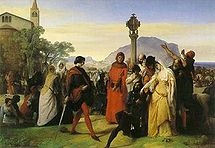 Charles had fully solidified his rule over Durazzo by 1272, creating a small Kingdom of Albania
Charles had fully solidified his rule over Durazzo by 1272, creating a small Kingdom of Albania
for himself, out of previously Despotate of Epiros territory; he was well received by local chiefs.
Charles was driven out of Sicily in 1282, but his successors ruled Naples until 1435.
, which ruled Hungary (1308–1385, 1386–1395) and Poland (1370–1399), Anjou-Taranto
, which ruled the remnants of the Latin Empire
(1313–1374) and Anjou-Durazzo, which ruled Naples (1382–1435) and Hungary (1385–1386).
The line became extinct in the male line with the death of King Ladislaus of Naples in 1414, and totally extinct with the death of his sister Joan II
in 1435.
Capetian dynasty
The Capetian dynasty , also known as the House of France, is the largest and oldest European royal house, consisting of the descendants of King Hugh Capet of France in the male line. Hugh Capet himself was a cognatic descendant of the Carolingians and the Merovingians, earlier rulers of France...
House of Anjou, also known as the House of Anjou-Sicily and House of Anjou-Naples, was a royal house
Royal House
A royal house or royal dynasty consists of at least one, but usually more monarchs who are related to one another, as well as their non-reigning descendants and spouses. Monarchs of the same realm who are not related to one another are usually deemed to belong to different houses, and each house is...
and cadet branch of the direct House of Capet
House of Capet
The House of Capet, or The Direct Capetian Dynasty, , also called The House of France , or simply the Capets, which ruled the Kingdom of France from 987 to 1328, was the most senior line of the Capetian dynasty – itself a derivative dynasty from the Robertians. As rulers of France, the dynasty...
. Founded by Charles I of Sicily
Charles I of Sicily
Charles I , known also as Charles of Anjou, was the King of Sicily by conquest from 1266, though he had received it as a papal grant in 1262 and was expelled from the island in the aftermath of the Sicilian Vespers of 1282...
, a son of Louis VIII of France
Louis VIII of France
Louis VIII the Lion reigned as King of France from 1223 to 1226. He was a member of the House of Capet. Louis VIII was born in Paris, France, the son of Philip II Augustus and Isabelle of Hainaut. He was also Count of Artois, inheriting the county from his mother, from 1190–1226...
, the Capetian king first ruled the Kingdom of Sicily
Kingdom of Sicily
The Kingdom of Sicily was a state that existed in the south of Italy from its founding by Roger II in 1130 until 1816. It was a successor state of the County of Sicily, which had been founded in 1071 during the Norman conquest of southern Italy...
during the 13th century. Later the War of the Sicilian Vespers
War of the Sicilian Vespers
The War of the ' Vespers started with the insurrection of the Sicilian Vespers against Charles of Anjou in 1282 and finally ended with the peace of Caltabellotta in 1302...
forced him out of the island of Sicily, leaving him with just the southern half of the Italian Peninsula
Italian Peninsula
The Italian Peninsula or Apennine Peninsula is one of the three large peninsulas of Southern Europe , spanning from the Po Valley in the north to the central Mediterranean Sea in the south. The peninsula's shape gives it the nickname Lo Stivale...
— the Kingdom of Naples
Kingdom of Naples
The Kingdom of Naples, comprising the southern part of the Italian peninsula, was the remainder of the old Kingdom of Sicily after secession of the island of Sicily as a result of the Sicilian Vespers rebellion of 1282. Known to contemporaries as the Kingdom of Sicily, it is dubbed Kingdom of...
. The house and its various branches would go on to influence much of the history of Southern
Southern Europe
The term Southern Europe, at its most general definition, is used to mean "all countries in the south of Europe". However, the concept, at different times, has had different meanings, providing additional political, linguistic and cultural context to the definition in addition to the typical...
and Central Europe
Central Europe
Central Europe or alternatively Middle Europe is a region of the European continent lying between the variously defined areas of Eastern and Western Europe...
during the Middle Ages
Middle Ages
The Middle Ages is a periodization of European history from the 5th century to the 15th century. The Middle Ages follows the fall of the Western Roman Empire in 476 and precedes the Early Modern Era. It is the middle period of a three-period division of Western history: Classic, Medieval and Modern...
, until becoming defunct in 1435.
In its time, the House ruled Naples
Naples
Naples is a city in Southern Italy, situated on the country's west coast by the Gulf of Naples. Lying between two notable volcanic regions, Mount Vesuvius and the Phlegraean Fields, it is the capital of the region of Campania and of the province of Naples...
and Sicily
Sicily
Sicily is a region of Italy, and is the largest island in the Mediterranean Sea. Along with the surrounding minor islands, it constitutes an autonomous region of Italy, the Regione Autonoma Siciliana Sicily has a rich and unique culture, especially with regard to the arts, music, literature,...
, Hungary
Hungary
Hungary , officially the Republic of Hungary , is a landlocked country in Central Europe. It is situated in the Carpathian Basin and is bordered by Slovakia to the north, Ukraine and Romania to the east, Serbia and Croatia to the south, Slovenia to the southwest and Austria to the west. The...
, Croatia
Croatia
Croatia , officially the Republic of Croatia , is a unitary democratic parliamentary republic in Europe at the crossroads of the Mitteleuropa, the Balkans, and the Mediterranean. Its capital and largest city is Zagreb. The country is divided into 20 counties and the city of Zagreb. Croatia covers ...
, and Poland
Poland
Poland , officially the Republic of Poland , is a country in Central Europe bordered by Germany to the west; the Czech Republic and Slovakia to the south; Ukraine, Belarus and Lithuania to the east; and the Baltic Sea and Kaliningrad Oblast, a Russian exclave, to the north...
.
Rise of Charles I and his sons

House of Capet
The House of Capet, or The Direct Capetian Dynasty, , also called The House of France , or simply the Capets, which ruled the Kingdom of France from 987 to 1328, was the most senior line of the Capetian dynasty – itself a derivative dynasty from the Robertians. As rulers of France, the dynasty...
king Louis VIII of France
Louis VIII of France
Louis VIII the Lion reigned as King of France from 1223 to 1226. He was a member of the House of Capet. Louis VIII was born in Paris, France, the son of Philip II Augustus and Isabelle of Hainaut. He was also Count of Artois, inheriting the county from his mother, from 1190–1226...
the Lion, Charles was first given a noble title by his brother Louis IX of France
Louis IX of France
Louis IX , commonly Saint Louis, was King of France from 1226 until his death. He was also styled Louis II, Count of Artois from 1226 to 1237. Born at Poissy, near Paris, he was an eighth-generation descendant of Hugh Capet, and thus a member of the House of Capet, and the son of Louis VIII and...
who succeeded to the French throne in 1246. Charles was named Count of Anjou and Maine; the feudal County of Anjou
Anjou
Anjou is a former county , duchy and province centred on the city of Angers in the lower Loire Valley of western France. It corresponds largely to the present-day département of Maine-et-Loire...
was a western vassal state of the Kingdom of France
Kingdom of France
The Kingdom of France was one of the most powerful states to exist in Europe during the second millennium.It originated from the Western portion of the Frankish empire, and consolidated significant power and influence over the next thousand years. Louis XIV, also known as the Sun King, developed a...
, which the Capetians had wrested from the House of Plantagenet
House of Plantagenet
The House of Plantagenet , a branch of the Angevins, was a royal house founded by Geoffrey V of Anjou, father of Henry II of England. Plantagenet kings first ruled the Kingdom of England in the 12th century. Their paternal ancestors originated in the French province of Gâtinais and gained the...
only a few decades earlier. Charles married the heiress of the County of Provence named Beatrice of Provence
Beatrice of Provence
Beatrice of Provence , was a countess regnant of Provence. She was also a Queen consort of Sicily by marriage to King Charles I of Sicily....
, she was a member of the House of Barcelona
House of Barcelona
The House of Barcelona was a medieval dynasty that ruled the County of Barcelona continuously from 878 and the Crown of Aragon from 1137 . From the male part they descend from the Bellonids, the descendants of Wifred the Hairy...
; this meant Charles' holdings were growing as Count of Provence. After fighting in the Seventh Crusade
Seventh Crusade
The Seventh Crusade was a crusade led by Louis IX of France from 1248 to 1254. Approximately 800,000 bezants were paid in ransom for King Louis who, along with thousands of his troops, was captured and defeated by the Egyptian army led by the Ayyubid Sultan Turanshah supported by the Bahariyya...
, Charles was offered by Pope Clement IV
Pope Clement IV
Pope Clement IV , born Gui Faucoi called in later life le Gros , was elected Pope February 5, 1265, in a conclave held at Perugia that took four months, while cardinals argued over whether to call in Charles of Anjou, the youngest brother of Louis IX of France...
, the Kingdom of Sicily
Kingdom of Sicily
The Kingdom of Sicily was a state that existed in the south of Italy from its founding by Roger II in 1130 until 1816. It was a successor state of the County of Sicily, which had been founded in 1071 during the Norman conquest of southern Italy...
— which at the time included not only the island of Sicily
Sicily
Sicily is a region of Italy, and is the largest island in the Mediterranean Sea. Along with the surrounding minor islands, it constitutes an autonomous region of Italy, the Regione Autonoma Siciliana Sicily has a rich and unique culture, especially with regard to the arts, music, literature,...
but also the southern half of the Italian Peninsula
Italian Peninsula
The Italian Peninsula or Apennine Peninsula is one of the three large peninsulas of Southern Europe , spanning from the Po Valley in the north to the central Mediterranean Sea in the south. The peninsula's shape gives it the nickname Lo Stivale...
. The reason for Charles being offered the kingdom was because of a conflict between the Papacy and the Holy Roman Empire
Holy Roman Empire
The Holy Roman Empire was a realm that existed from 962 to 1806 in Central Europe.It was ruled by the Holy Roman Emperor. Its character changed during the Middle Ages and the Early Modern period, when the power of the emperor gradually weakened in favour of the princes...
, the latter of whom were represented by the ruling House of Hohenstaufen.
It was at the Battle of Benevento
Battle of Benevento
The Battle of Benevento was fought near Benevento, in present-day Southern Italy, on February 26, 1266, between the troops of Charles of Anjou and Manfred of Sicily. Manfred's defeat and death resulted in the capture of the Kingdom of Sicily by Charles....
that the Guelph
Guelphs and Ghibellines
The Guelphs and Ghibellines were factions supporting the Pope and the Holy Roman Emperor, respectively, in central and northern Italy. During the 12th and 13th centuries, the split between these two parties was a particularly important aspect of the internal policy of the Italian city-states...
Capetians gained the Sicilian kingdom from the Ghibelline Swabians, this was cemented after victory at Tagliacozzo
Battle of Tagliacozzo
The Battle of Tagliacozzo was fought on 23 August 1268 between the French, Provençal, and Italian forces of Charles of Anjou and the Italian, Spanish, Roman, Arab and German troops of the Hohenstaufen army, led by Conradin , the sixteen year old Duke of Swabia and claimant to the throne of Sicily...
. In keeping with the political landscape of the period, Charles is described by scholars as shrewd, energetic and highly ambitious; he dreamed of empire. He signed the Treaty of Viterbo
Treaty of Viterbo
The Treaty of Viterbo was a pair of agreements made by Charles I of Sicily with Baldwin II of Constantinople and William II Villehardouin, Prince of Achaea, on 27 May 1267, which transferred much of the rights to the Latin Empire from Baldwin to Charles.-Background:The recapture of Constantinople...
in 1267 with Baldwin II of Courtenay and William II of Villehardouin
William II of Villehardouin
William II of Villehardouin, was the last Villehardouin prince of Achaea and ruled the principality at the height of its power and influence.William was the son of Geoffrey I Villehardouin...
, the political alliance gave much of the rights to the Latin Empire
Latin Empire
The Latin Empire or Latin Empire of Constantinople is the name given by historians to the feudal Crusader state founded by the leaders of the Fourth Crusade on lands captured from the Byzantine Empire. It was established after the capture of Constantinople in 1204 and lasted until 1261...
to Charles and a marriage alliance for his daughter Beatrice of Sicily
Beatrice of Sicily
Beatrice of Sicily was the Empress consort of Philip of Courtenay, titular Latin Emperor of Constantinople.-Family:...
. The Byzantines had taken back the city of Constantinople
Constantinople
Constantinople was the capital of the Roman, Eastern Roman, Byzantine, Latin, and Ottoman Empires. Throughout most of the Middle Ages, Constantinople was Europe's largest and wealthiest city.-Names:...
in 1261 and this was a plan to take it back from Michael VIII Palaiologos
Michael VIII Palaiologos
Michael VIII Palaiologos or Palaeologus reigned as Byzantine Emperor 1259–1282. Michael VIII was the founder of the Palaiologan dynasty that would rule the Byzantine Empire until the Fall of Constantinople in 1453...
. It also recognised Charles' possession of Corfu
Corfu
Corfu is a Greek island in the Ionian Sea. It is the second largest of the Ionian Islands, and, including its small satellite islands, forms the edge of the northwestern frontier of Greece. The island is part of the Corfu regional unit, and is administered as a single municipality. The...
and cities in the Balkans such as Durazzo, as well as giving him suzerainty over the Principality of Achaea
Principality of Achaea
The Principality of Achaea or of the Morea was one of the three vassal states of the Latin Empire which replaced the Byzantine Empire after the capture of Constantinople during the Fourth Crusade. It became a vassal of the Kingdom of Thessalonica, along with the Duchy of Athens, until Thessalonica...
and sovereignty of the Aegean islands
Aegean Islands
The Aegean Islands are the group of islands in the Aegean Sea, with mainland Greece to the west and north and Turkey to the east; the island of Crete delimits the sea to the south, those of Rhodes, Karpathos and Kasos to the southeast...
aside from those already held by the Republic of Venice
Republic of Venice
The Republic of Venice or Venetian Republic was a state originating from the city of Venice in Northeastern Italy. It existed for over a millennium, from the late 7th century until 1797. It was formally known as the Most Serene Republic of Venice and is often referred to as La Serenissima, in...
. For a while Charles was preoccupied helping his French brother in the unsuccessful Eighth Crusade
Eighth Crusade
The Eighth Crusade was a crusade launched by Louis IX, King of France, in 1270. The Eighth Crusade is sometimes counted as the Seventh, if the Fifth and Sixth Crusades of Frederick II are counted as a single crusade...
on Tunis
Tunis
Tunis is the capital of both the Tunisian Republic and the Tunis Governorate. It is Tunisia's largest city, with a population of 728,453 as of 2004; the greater metropolitan area holds some 2,412,500 inhabitants....
. After this he once again focused on Constantinople, but his fleet was wrecked in a freak storm off the coast of Trapani
Trapani
Trapani is a city and comune on the west coast of Sicily in Italy. It is the capital of the Province of Trapani. Founded by Elymians, the city is still an important fishing port and the main gateway to the nearby Egadi Islands.-History:...
. With the elevation of Pope Gregory X
Pope Gregory X
Pope Blessed Gregory X , born Tebaldo Visconti, was Pope from 1271 to 1276. He was elected by the papal election, 1268–1271, the longest papal election in the history of the Roman Catholic Church....
, there was a truce between Charles and Michael in the form of the Council of Lyons
Second Council of Lyon
The Second Council of Lyon was the fourteenth ecumenical council of the Catholic Church, convoked on 31 March 1272 and convened in Lyon, France, in 1274. Pope Gregory X presided over the council, called to act on a pledge by Byzantine emperor Michael VIII to reunite the Eastern church with the West...
, as Christians focused on improving ecumenical relations, with hopes of regaining the Kingdom of Jerusalem
Kingdom of Jerusalem
The Kingdom of Jerusalem was a Catholic kingdom established in the Levant in 1099 after the First Crusade. The kingdom lasted nearly two hundred years, from 1099 until 1291 when the last remaining possession, Acre, was destroyed by the Mamluks, but its history is divided into two distinct periods....
back from the Muslims.

Kingdom of Albania
The Kingdom of Albania, or Regnum Albaniae, was established by Charles of Anjou in the Albanian territory he conquered from the Despotate of Epirus in 1271. He took the title of "King of Albania" in February 1272. The kingdom extended from the region of Durrës south along the coast to Butrint...
for himself, out of previously Despotate of Epiros territory; he was well received by local chiefs.
Charles was driven out of Sicily in 1282, but his successors ruled Naples until 1435.
Charles II, divided inheritance
This House of Anjou included the branches of Anjou-HungaryLands of the Crown of St. Stephen
The historical term Lands of the Crown of Saint Stephen was used to denote a group of territories connected to the Kingdom of Hungary within Austria-Hungary...
, which ruled Hungary (1308–1385, 1386–1395) and Poland (1370–1399), Anjou-Taranto
Taranto
Taranto is a coastal city in Apulia, Southern Italy. It is the capital of the Province of Taranto and is an important commercial port as well as the main Italian naval base....
, which ruled the remnants of the Latin Empire
Latin Empire
The Latin Empire or Latin Empire of Constantinople is the name given by historians to the feudal Crusader state founded by the leaders of the Fourth Crusade on lands captured from the Byzantine Empire. It was established after the capture of Constantinople in 1204 and lasted until 1261...
(1313–1374) and Anjou-Durazzo, which ruled Naples (1382–1435) and Hungary (1385–1386).
The line became extinct in the male line with the death of King Ladislaus of Naples in 1414, and totally extinct with the death of his sister Joan II
Joan II of Naples
Joan II was Queen of Naples from 1414 to her death, upon which the senior Angevin line of Naples became extinct. As a mere formality, she used the title of Queen of Jerusalem, Sicily, and Hungary....
in 1435.
Designation and details
| Title | Held | Designation and details |
|---|---|---|
| Count of Anjou | 1246–1297 | Awarded to Charles I by his brother. Remained under direct control of the Capetian House of Anjou until passing to another Capetian branch the House of Valois by marriage. |
| Count of Maine | 1246–1309 | Awarded to Charles I by his brother. Remained under direct control of the Capetian House of Anjou until passing to another Capetian branch the House of Valois-Anjou House of Valois-Anjou The Valois House of Anjou, or the Younger House of Anjou, was a noble French family, deriving from the royal family, the House of Valois. They were monarchs of Naples, as well as various other territories.... by creation of John II of France John II of France John II , called John the Good , was the King of France from 1350 until his death. He was the second sovereign of the House of Valois and is perhaps best remembered as the king who was vanquished at the Battle of Poitiers and taken as a captive to England.The son of Philip VI and Joan the Lame,... . |
| Count of Provence | 1246–1382 | Inherited by marriage between Charles I and Beatrice of Provence Beatrice of Provence Beatrice of Provence , was a countess regnant of Provence. She was also a Queen consort of Sicily by marriage to King Charles I of Sicily.... who held the county. Issueless Joan I of Naples Joan I of Naples Joan I , born Joanna of Anjou, was Queen of Naples from 1343 until her death. She was also Countess of Provence and Forcalquier, Queen consort of Majorca and titular Queen of Jerusalem and Sicily 1343–82, and Princess of Achaea 1373/5–81.... left the county to Louis I of Anjou of the House of Valois-Anjou. |
| King of Sicily | 1266–1282 | Won the kingdom through conquest. |
Kingdom of Sicily
| Portrait | Name | From | Until | Relationship with predecessor |
|---|---|---|---|---|
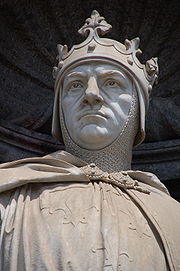 |
Charles I of Sicily Charles I of Sicily Charles I , known also as Charles of Anjou, was the King of Sicily by conquest from 1266, though he had received it as a papal grant in 1262 and was expelled from the island in the aftermath of the Sicilian Vespers of 1282... |
6 January 1266 | 4 September 1282 | no direct relation to Manfred of Sicily Manfred of Sicily Manfred was the King of Sicily from 1258 to 1266. He was a natural son of the emperor Frederick II of Hohenstaufen but his mother, Bianca Lancia , is reported by Matthew of Paris to have been married to the emperor while on her deathbed.-Background:Manfred was born in Venosa... , won the kingdom through right of conquest Right of conquest The right of conquest is the right of a conqueror to territory taken by force of arms. It was traditionally a principle of international law which has in modern times gradually given way until its proscription after the Second World War when the crime of war of aggression was first codified in the... . |
Kingdom of Naples
| Portrait | Name | Branch | From | Until | Relationship with predecessor |
|---|---|---|---|---|---|
 |
Charles I of Naples | Anjou-Sicily | 4 September 1282 | 7 January 1285 | the southern half of the Italian Peninsula was part of the Kingdom of Sicily before the Sicilian Vespers Sicilian Vespers The Sicilian Vespers is the name given to the successful rebellion on the island of Sicily that broke out on the Easter of 1282 against the rule of the French/Angevin king Charles I, who had ruled the Kingdom of Sicily since 1266. Within six weeks three thousand French men and women were slain by... forced Charles out of the island. |
 |
Charles II of Naples Charles II of Naples Charles II, known as "the Lame" was King of Naples, King of Albania, Prince of Salerno, Prince of Achaea and Count of Anjou.-Biography:... (Charles the Lame) |
Anjou-Sicily | 7 January 1285 | 5 May 1309 | son of Charles I of Naples. |
.jpg) |
Robert of Naples Robert of Naples Robert of Anjou , known as Robert the Wise was King of Naples, titular King of Jerusalem and Count of Provence and Forcalquier from 1309 to 1343, the central figure of Italian politics of his time. He was the third but eldest surviving son of King Charles II of Naples the Lame and Maria of Hungary... (Robert the Wise) |
Anjou-Naples | 5 May 1309 | 20 January 1343 | son of Charles II of Naples. |
.jpg) |
Joan I of Naples Joan I of Naples Joan I , born Joanna of Anjou, was Queen of Naples from 1343 until her death. She was also Countess of Provence and Forcalquier, Queen consort of Majorca and titular Queen of Jerusalem and Sicily 1343–82, and Princess of Achaea 1373/5–81.... |
Anjou-Naples | 20 January 1343 | 12 May 1382 | granddaughter of Robert of Naples. Daughter of Charles, Duke of Calabria Charles, Duke of Calabria Charles, Duke of Calabria was the son of King Robert of Naples and Yolanda of Aragon.-Biography:Born in Naples, he became Duke of Calabria in 1309 on his father's accession, and was created Vicar-General of the Kingdom of Sicily... |
.jpg) |
Charles III of Naples Charles III of Naples Charles the Short or Charles of Durazzo was King of Naples and titular King of Jerusalem from 1382 to 1386 as Charles III, and King of Hungary from 1385 to 1386 as Charles II. In 1382 Charles created the order of Argonauts of Saint Nicholas... (Charles the Short) |
Anjou-Durazzo | 12 May 1382 | 24 February 1386 | second cousin of Joan I of Naples, whom he had murdered. Son of Louis of Durazzo Louis of Durazzo Louis of Durazzo was Count of Gravina and Morrone. He was the son of John of Gravina and Agnes of Périgord.In 1337, he was named Vicar- and Captain-General of the Kingdom of Albania. During the ascension of the Durazzeschi at the court of Naples during the reign of Joan I, he was one of the royal... . |
.jpg) |
Ladislaus of Naples | Anjou-Durazzo | 24 February 1386 | 6 August 1414 | son of Charles III of Naples. |
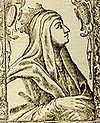 |
Joan II of Naples Joan II of Naples Joan II was Queen of Naples from 1414 to her death, upon which the senior Angevin line of Naples became extinct. As a mere formality, she used the title of Queen of Jerusalem, Sicily, and Hungary.... |
Anjou-Durazzo | 6 August 1414 | 2 February 1435 | sister of Ladislaus of Naples, daughter of Charles III of Naples. |
Hungary
| Portrait | Name | Branch | From | Until | Relationship with predecessor |
|---|---|---|---|---|---|
.jpg) |
Charles I of Hungary Charles I of Hungary Charles I , also known as Charles Robert , was the first King of Hungary and Croatia of the House of Anjou. He was also descended from the old Hungarian Árpád dynasty. His claim to the throne of Hungary was contested by several pretenders... |
Anjou-Hungary | 12 July 1312 | 16 July 1342 | great-grandnephew (first-cousin thrice removed) of Andrew III of Hungary, the last Árpád agnate Árpád dynasty The Árpáds or Arpads was the ruling dynasty of the federation of the Hungarian tribes and of the Kingdom of Hungary . The dynasty was named after Grand Prince Árpád who was the head of the tribal federation when the Magyars occupied the Carpathian Basin, circa 895... . |
 |
Louis I of Hungary (Louis the Great) |
Anjou-Hungary | 16 July 1342 | 10 September 1382 | son of Charles I of Hungary. |
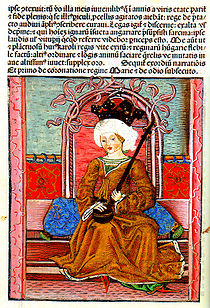 |
Mary of Hungary Mary of Hungary Mary of Anjou was queen regnant of Hungary from 1382 until her death in 1395.-Childhood:... |
Anjou-Hungary | 10 September 1382 | December 1385 | daughter of Louis I of Hungary. |
 |
Charles II of Hungary Charles III of Naples Charles the Short or Charles of Durazzo was King of Naples and titular King of Jerusalem from 1382 to 1386 as Charles III, and King of Hungary from 1385 to 1386 as Charles II. In 1382 Charles created the order of Argonauts of Saint Nicholas... (Charles the Short of Naples) |
Anjou(-Durazzo) | December 1385 | 24 February 1386 | second-cousin once removed of Mary of Hungary; great-grandson of Charles II of Naples Charles II of Naples Charles II, known as "the Lame" was King of Naples, King of Albania, Prince of Salerno, Prince of Achaea and Count of Anjou.-Biography:... . Usurped the throne from her. |
 |
Mary of Hungary Mary of Hungary Mary of Anjou was queen regnant of Hungary from 1382 until her death in 1395.-Childhood:... (restored) |
Anjou-Hungary | 24 February 1386 | 17 May 1395 | second-cousin once removed of Charles II of Hungary; great-great granddaughter of Charles II of Naples. |
Kingdom of Poland
| Portrait | Name | Branch | From | Until | Relationship with predecessor |
|---|---|---|---|---|---|
 |
Louis of Poland (Louis the Great of Hungary) |
Anjou-Hungary | 17 November 1370 | 10 September 1382 | nephew of Casimir III of Poland Casimir III of Poland Casimir III the Great , last King of Poland from the Piast dynasty , was the son of King Władysław I the Elbow-high and Hedwig of Kalisz.-Biography:... , the last Piast agnate Piast dynasty The Piast dynasty was the first historical ruling dynasty of Poland. It began with the semi-legendary Piast Kołodziej . The first historical ruler was Duke Mieszko I . The Piasts' royal rule in Poland ended in 1370 with the death of king Casimir the Great... . |
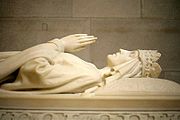 |
Jadwiga of Poland Jadwiga of Poland Jadwiga was monarch of Poland from 1384 to her death. Her official title was 'king' rather than 'queen', reflecting that she was a sovereign in her own right and not merely a royal consort. She was a member of the Capetian House of Anjou, the daughter of King Louis I of Hungary and Elizabeth of... |
Anjou-Hungary | 16 October 1384 | 17 July 1399 | daughter of Louis of Poland. |

